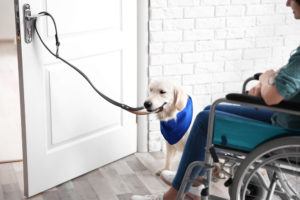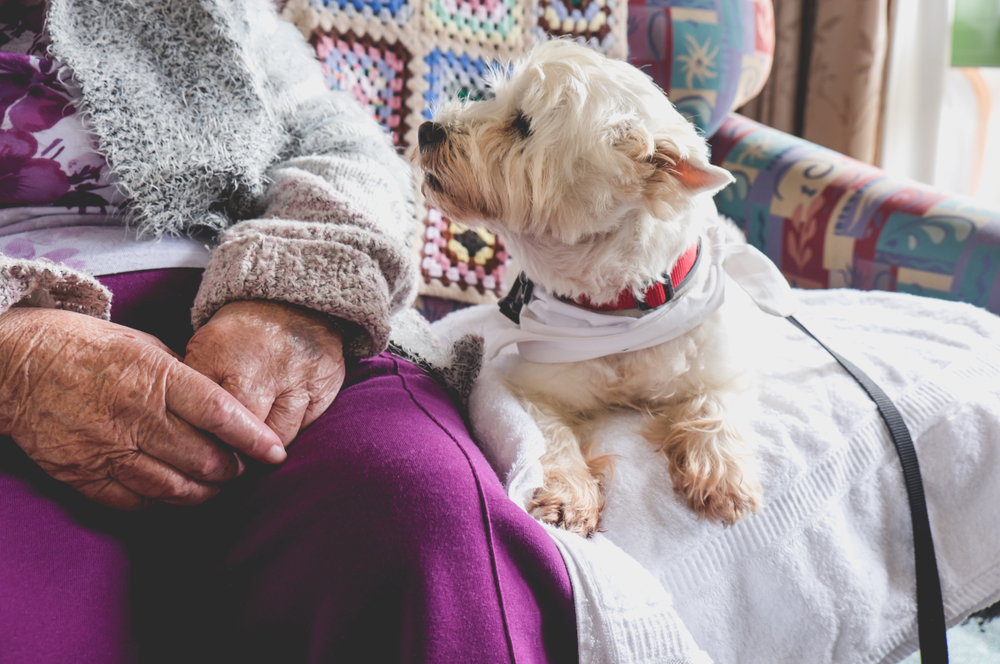Positive Impact Of Pets
The UK is a nation of pet lovers.
A quarter of the population owns an estimated 11.1 million cats and 24%, around 8.9 million dogs. Owning a pet can make a positive difference to your life and bring you immense pleasure; increasing your wellbeing and actually helping you carry out daily tasks.

Man's best friend? - The facts about pet ownership
Taking on a pet is a decision that needs huge consideration and one that cannot be taken lightly. Bringing a pet into your life will have a big impact in terms of responsibility, financial commitment and time management; it will inevitably bring about many changes to your current lifestyle. So before deciding to get a pet, do take time to think about the commitment and changes he or she will bring.
To help you decide, read about the health and wellbeing benefits of having a pet; and the amazing role pets can play in helping you in your daily life.
We've also put together a list of equipment to help make looking after a pet easier.
For expert advice on buying and owning a pet you can visit the websites of the organisations below:
If you then decide that having a pet is right for you – enjoy!
Already have a pet?
 Many of you will already have a pet and know the benefits that they bring.
Many of you will already have a pet and know the benefits that they bring.
We’d love to see your pets so why not share your story and photos with us, as well as telling us about any equipment you have found helpful.
Having a pet is good for you! - The health and wellbeing benefits of having a pet
Although research into the benefits of pet ownership may not be that robust (appropriate scientific methodology and validation of results are not always used in some studies), a number of research studies do reliably demonstrate that pet ownership is good for you.
Whether your pet is furry, feathered or scaly, your best friend, confidante, or helper - they’re more than just fun to have around.
Pets can boost your cardiovascular health
The effect of this is to reduce your chances of developing conditions that affect your heart and blood, such as stroke or coronary heart disease. This may be due to a number of factors: -
- Increased Physical Fitness: Having a pet can increase your physical activity – through frequent trips outside or walks with your animal. Dog walking has also been shown to improve and sustain engagement in physical activity (1), (2). Large dog owners tend to walk more than small dog owners (3); and older pet owners have found they have been able to carry out daily activities for longer (4).
- Lower Blood Pressure: Having a pet is believed to lower blood pressure especially in high-risk or hypertensive people.One study (5) found that pet owners had a higher survival rate one year after discharge from a coronary care unit; another (6) found that subjects had lower blood pressure and heart rates in situations of acute mental stress if their pet was with them; and a third (7) suggests that cat owners are 30% less likely to have a heart attack and 40% less likely to have a stroke.

Pets can have a positive impact on our mental health by: -
Lowering Stress & Anxiety:
It’s not just the exercise involved in having a pet that’s beneficial; the stress relief and companionship they bring also have very physical benefits. Whether you get comfort, cuddles, laughter or physical activity, from your pet, it leads to a release in calming endorphins.
- Humans and their pet dogs both experience increased levels of oxytocin, (a hormone that is also triggered by activities such as hugging), when they are interacting (8). Oxytocin influences the brain’s ability to embrace social qualities such as empathy, trust, and memory of social cues; for example, letting you know when you should take comfort in others. It also works cross-species: dog owners experienced an average oxytocin boost of 6.6% after scratching and petting their pets, in a study that measured the effect in real-time (9). Contact with pet dogs also caused a decrease in levels of cortisol, a hormonal alarm system for stress, in humans.
- Increased calmness can also arise from simple activities such as watching the smooth movements of a swimming fish. People using pet therapy while recovering from surgery use less pain relief than those without a pet.

Supporting wellbeing:
Pet owners have been found to be more satisfied with life compared with those without pets (13). As well as protecting your mental wellbeing, pets can also help you manage long-term mental health problems (14). Pets are a valuable source of support for those managing long-term conditions, and can provide a welcome distraction from symptoms or upsetting experiences - and lots of encouragement.
Increasing social engagement and reducing isolation:
Even though we feel grumpy sometimes and think we like quiet, humans are social animals. It is important for our physical and mental health to have contact with other people – and pets are a brilliant way to get us talking.
- Social isolation is a huge health problem, particularly as we get older. In fact, it can increase your chances of dying early. Pets don’t just increase the number of off-chance chats you have, they also inspire trust in you as a person - and are brilliant ice-breakers (10). What may seem like a trivial chat over the garden wall when you’re looking for your cat, or in the park when you’re walking your dog actually increases the perception that you are a friendly person. It can even help you connect on social media, with thousands of pet related pages and forums across the internet including dating agencies! You can even make a social media page for your pet!
- Companionship is also a key part of owning a pet and helps prevent loneliness.
As companions, pets give you a sense of purpose and routine, and a reason to wake up every morning. The health benefits we get from our pets mirror those we get from human relationships (11), which can be particularly helpful for people who find themselves alone. Relationships with pets are also less likely to have the ups and downs you get with humans, making them much more consistent.
Having a friendly face at home can help you stave off common mental health problems where loneliness is a contributory factor. A 2009 study (12) found that pet-owners over the age of 60 who lived alone were four times less likely to develop clinical depression compared with people who didn’t have pets.

With all these benefits involved, having a pet can really improve your health and wellbeing – as long as it’s the right fit for you and your lifestyle. Pets can also help you with practical, daily tasks – read about pets with specific jobs below.
Dogs with jobs - How having a pet can help you in your daily life
The role of dogs in helping people with specific needs has grown considerably in recent years. Whilst most of us have heard of dogs supporting people with visual and hearing impairment, assistance and therapy dogs can support people with a wider range of needs.
Assistance dogs
'Assistance dog' is the internationally established term for a dog that provides assistance to a disabled person, and is task-trained to help mitigate the handler's disability (Wikipedia).
To be considered an assistance dog, dogs must meet the following criteria:
- The dog’s partner must be disabled and meet the legal definition of disability in the specific country or region
- The dog must be specifically trained to lessen the impact of the partner’s disability in some way, e.g. opening doors, detecting high blood sugar or allergens and notifying of such, alerting to a ringing phone, leading those who are visually or mobility impaired
- The dog must be trained to a high level not to be a nuisance in public, to be safe with members of the public and well-behaved, as well as being healthy and not posing a hygiene threat
- Some assistance dogs wear harnesses that identify them as an assistance dog in bold letters, but this is not required by law.

Traditionally, assistance dogs have been trained by charities and other organisations who would then partner a disabled person with a fully trained dog. A dog is about 2 years old when it has completed its training programme.
Increasingly, disabled people are choosing and training their own assistance dogs. The disabled person picks a dog (often referred to as a 'prospect') and trains it, eventually becoming its handler. The length and type of training that any future assistance dog receives varies immensely; however all assistance dog candidates will need to go through a specific programme.
An assistance dog is legally permitted to accompany its client, owner, or partner, at all times and in all places, within the United Kingdom.
Therapy Dogs*
‘A therapy dog’ is a general term, often used to describe a dog that is used to bring therapeutic benefits to people. This covers a wide range of potential activities for a wide range of potential clients. Some dogs take part in visiting programmes, whilst others take part in structured activities as part of a therapeutic programme or practice. Some things to know about therapy dogs: -
- In the UK therapy dogs are not considered to be assistance dogs. This is because an assistance dog is trained to perform specific tasks to help a disabled person. The dog is usually ‘qualified’ through one of the charitable organisations registered as members of Assistance Dogs UK.
- A therapy dog does not have these same legal privileges as assistance dogs.
- Therapy dogs can be any breed and any size – from a Chihuahua to a Great Dane, from a Staffy to a Rottweiler, to a Poodle. What is important is whether they are suitable for the activities they are going to undertake, in terms of age, temperament, health, and training.

Interested in having a therapy dog?
If you want your dog to become a therapy dog, it depends on the activities you are expecting of it and your dog’s suitability to undertake the proposed activities. If you’ve got an idea about what you’d like to do with your dog in a therapeutic setting, you can then determine whether they are suitable.
In the UK, there are two main organisations that manage visiting programmes, along with some other therapeutic activities – ‘Pets As Therapy’ in England and ‘Therapet’ in Scotland. Both of these organisations carry out their own assessments to determine whether a dog (or other pet) is suitable to take part in a specific activity. We recommend contacting one of these organisations if you would like to explore this further.
If you’re seeking to get your dog trained as a therapy dog, where it’s trained depends on what you want your dog to do and what will be expected of him/her. For example, your dog might not need much training, beyond basic obedience, if it’s going to be part of a visiting programme. There are more advanced and specific areas of training that dogs can take part in for more therapeutic activities.
If you’re thinking of getting a dog and would like to get one that’s suitable for therapy work you aren’t confined to only one sort of dog. All sorts of dogs can become therapy dogs, it really doesn’t come down to breed or size or type. What are more important are things like temperament and health. Your dog will also need a certain level of training for more advanced therapeutic activities. A calm and friendly manner, that is not too boisterous, will be important for most therapeutic activities and visiting programmes.
*Source: Society for Companion Animal Studies website




